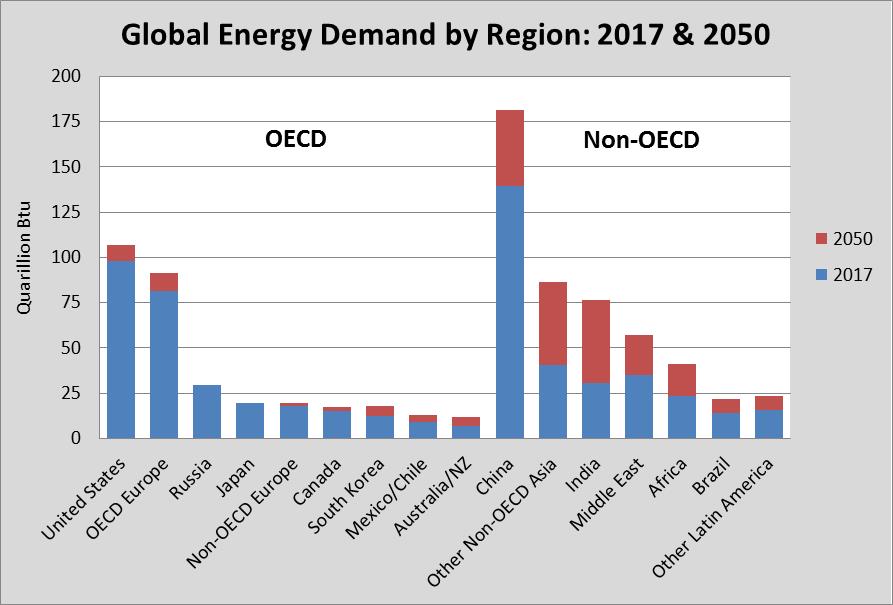
The Energy Information Administration’s (EIA) latest International Energy Outlook 2017 (IEO) is hot off the presses. It provides a look at global trends in energy supply and demand from 2012 out to 2050.
With the normal caveats about the difficulty of predicting the future, let’s take a look at some of the IEO 2017’s highlights:
- Global Demand Growth: Energy demand between 2017 and 2050 is expected to grow by about 57% worldwide, most of which will come in non-Organization of Economic Co-operation and Development (OECD) countries. EIA expects that while OECD demand will climb nearly 15% over this period, non-OECD demand will leap 91%, with India, Southeast Asia, and Africa showing the fastest rates of growth (see the nearby chart).
- Electricity Grows Fastest: As in past years, electricity generation is the fastest growing source of energy, driven largely by increasing demand for electricity in Asia. EIA is forecasting a 60% increase in global power generation between now and 2050. Thanks to rising middle classes in many developing countries, transportation energy use also grows strongly (46%), as automobiles become within reach of more and more people.
- Hydrocarbon Fuels Continue to Dominate: Combined petroleum, natural gas, and coal use is forecast to grow 29% by 2050, with natural gas leading the way (up 67%) followed by petroleum (25%) and coal (3%—essentially flat). Although the share of energy demand met by fossil fuels declines by 2050, hydrocarbons nonetheless are expected to account for 77% of total global demand in 2050 compared to 83% in 2017. Of that 77%, about 30 percentage points are from petroleum, 26 percentage points from coal, and 22 percentage points from natural gas.
- Renewables Use Grows Rapidly: EIA expects demand for renewable energy (hydropower, wind, solar, biofuels, etc.) will nearly double, growing 96% between 2017 and 2050. The share of energy demand met by these technologies should climb from about 13% in 2017 to about 18% in 2050. Hydroelectric power will remain the largest single source of renewable electricity, accounting for about 54% of all renewable electricity generation in 2050.
- Nuclear: Nuclear power is forecast to grow 46% between now and 2050, a much slower rate of increase than in past IEOs. Its overall share of demand in 2050 is expected to be about 5%. China—now the fourth largest producer of electricity from nuclear plants after the U.S., France, and Russia—will become far and away the biggest producer in 2050. India, the Middle East, and South Korea also plan large nuclear builds, and it is expected that Japan will restart a large portion of its nuclear fleet now shut in because of the Fukushima Daiichi accident in 2011.
- Carbon Dioxide Emissions: EIA forecasts carbon dioxide emissions from energy rising 24% between now and 2050, from 34.5 to 42.8 billion metric tons of CO2. Almost all from developing countries, especially India and Southeast Asia. Interestingly, EIA forecasts that China’s emissions, after rising through the mid-2020s, will be about 4% lower in 2050 than in 2017, reflecting a much wealthier, more energy efficient country less dependent on energy-intensive industries than it is today. The projection for the U.S. includes the Clean Power Plan (which the Trump Administration is unwinding). It suggests U.S. energy-related CO2 emissions will decline about 2% by 2050.

